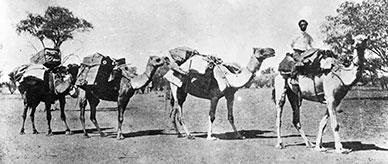
Transcript
Narrator: Ready for the first run each man brings his own jewellery: combs and cutters for the handpiece. The rest of the machinery belongs to the owner of the shed. They wear flannel shirts to absorb the sweat and special boots without nails because soon the board will be greasy and a slip with a razing handpiece could mean a wicked gash.
Some of the boys make their own moccasins, as they call them, out of sacking.
[MUSIC INTERLUDE]
[BELL RINGS]
Narrator: Perce and Steve are both out to be ringer [fastest shearer] of the shed, the man with the best daily tally. The wool rollers can take it easy for a little longer as they wait for their first fleece. In this game more haste means less speed and damaged sheep as well. It looks effortless but after a day of bent backs and concentration on the clean long swing of that strong right arm they’re mighty glad to fall in to bed.
It’s Perce who gets the first wool away but that’s only one sheep of the many that he and Steve will shear today.
The boys in rollers can’t smoke now. If the board isn’t kept clear there’ll be roars from the shearers, so the fleeces come over the rolling tables at a rate that keeps the rollers hard at work tearing off the dirty edges.
The aristocrat of the shearing shed is the wool classer – a highly paid expert who sorts the length of staple [cluster of wool fibres], texture and strength. He’s a key man in maintaining the world reputation of fine Australian wool.
The presser has one of the toughest jobs in the shed. He gets paid according to the weight of wool he presses.
Over it comes. Now he has to squeeze the contents of the top and bottom boxes together into the bale.
And there it is. 350 pounds of the world’s best wool.
[END]
About this record
This clip from 1950 shows activities in a typical wool shed on a sheep station in Victoria. It opens with information about the shearers' clothes and the equipment they use. Workers are shown rolling, sorting, baling and pressing wool for export. The clip is from a black-and-white Commonwealth Government documentary directed by Hugh Alexander and narrated by Ted Smith.
Educational value
- This clip outlines the process of preparing wool for export, including shearing sheep and handling, trimming, classing, pressing and baling wool. The shearers use mechanical shears, which had replaced hand shears from the 1880s. The wool classer grades the fleece and may also act as the shearing overseer. The pressing and baling of wool, a manual operation in this film, is now performed by mechanised presses.
- This clip depicts a significant Australian industry that has helped to shape the culture and economy of the country from the colonial era. Australia, described during the 1950s as ‘riding on the sheep’s back’, is still the world’s largest producer and exporter of wool. The shearer has become an iconic image of the Australian working man, partly through the poetry of Banjo Paterson and the paintings of Russell Drysdale and Tom Roberts.
- This clip suggests some of the pressures that shearers experience in a job that continues to be physically demanding, requires great skill, and pays only for the number of sheep shorn. The narrator states that, on average, shearers processed 130 sheep per day. Today, shearers typically shear about 100 sheep per day. A ‘gun shearer’ or 'ringer' (the fastest shearer in the shed) can shear 200–300 or more sheep per day.
- The clip highlights the effort and danger involved in manually pressing and baling wool and illustrates that work safety practices and technological developments have greatly changed since the 1950s. In this clip, two men use a windlass to operate the compression pump and press the wool. As well as eliminating dangerous practices, today’s mechanised wool presses increase the efficiency in wool production, with one man being able to press a bale alone.
- In 1951, the year this film was made, wool prices reached a record 144.2 pence per pound – representing 56 per cent of agricultural production – only to drop dramatically by half over the following two years. Britain was the main buyer of Australian wool exports. The availability of large areas of grazing land and the great demand for wool from overseas markets ensured that Australia enjoyed a long period of economic prosperity.
- The Shearers was produced by the Film Division (also known as Commonwealth Film Unit) of the Department of the Interior for the Australian National Film Board. It is one of several promotional documentaries and training films made to document postwar Australian life in the areas of education, industry and agriculture, science, sport, food and flora and fauna. The films were distributed and screened on television, in schools and workplaces throughout Australia and at Australian embassies overseas.
Acknowledgments
Learning resource text © Education Services Australia Limited and the National Archives of Australia 2010.
Need help with your research?
Learn how to interpret primary sources, use our collection and more.

